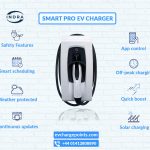One of the biggest challenges faced by the electric vehicle industry is the provision of accessible charging infrastructure. Many prospective EV drivers say that range and the fear of not making it to a charger is the biggest stumbling block they face.

That said, charging infrastructure in the UK is improving and is becoming more readily available across the country. EV manufacturers and other companies are developing ways to connect the EV driver with nearby charging points. The ultimate aim is to make it as easy to charge as it would be to fill up a traditional vehicle.
In the following, we have summarised some of the best ways to find charge points near you while out in your EV. Our aim is to show you that living with an EV has become as convenient, potentially even more convenient than the days of petrol and diesel.
Availability of charging in the UK
The UK has a particularly advanced EV charging network. We currently have over 33,000 individual public chargers in the UK across 12,000 locations, more than we have petrol stations, and this number is increasing rapidly.
The average UK citizen is around 3.8 miles from the closest charge point. However, these are concentrated around urban areas and affluent pockets of the country. For example, the largest distance between charge points is 37 miles in Cumbria but the largest distance between petrol stations is only 19 miles in the NW Scottish Highlands.
That said, the vast majority of us live in towns or cities and so will have access to EV charging nearby. With ranges on EVs now reaching the 300-mile mark, and the average UK driver travelling 20 miles per day, most of us will not need to charge daily.

Where can I charge my EV?
Public EV charging can take a number of forms. The most common is the traditional charging point provided at a service station, supermarket or another obvious stopping point for drivers. These can be provided by public funds through grants but may also have been installed by private companies.
For example, McDonalds has started to install charge points at all of their drive through locations in the UK. For many businesses, having a captive audience while they charge up can be a great marketing opportunity.
Charging can also be more concentrated at car parks or in designated charging hubs. For example, towns and cities like Oxford and Falkirk have recently opened largescale charging facilities to meet current and future demand.
Finally, charging can take the form of green parking bays in city or town centres. These may be the most recognisable and would be the best option for city workers or those out for the day.
What types of charger are there?
- Slow chargers
These are the basic chargers supplied with most electric cars and plug-in hybrid cars. They allow you to charge overnight using a standard 13-amp three-pin plug – although some come with a ‘Commando’ type plug for weatherproof outdoor applications. A typical maximum current draw of 3kW means a full charge usually takes between 8 and 24 hrs.
Given the length of time these batteries take, they are mostly used as home chargers and are very rarely available as public chargers.
- Fast chargers
Fast chargers are the most common public charger type. They tend to charge your vehicle in around 2-4 hrs. Fast chargers operate at up to 7kW and 32 amps. The connectors used to plug into Fast Chargers usually have Type 2 connectors. In 2014, the European Commission ruled that all new plug-in vehicles and charging stations should feature Type 2 connectors. New plug-in vehicles now feature Type 2 sockets as standard, but a single car may be compatible with multiple cables. As such, fast chargers are compatible with most EVs and provide the highest level of charging that most cars can handle.
- Rapid chargers
Some higher-spec electric cars have more advanced technology that can also handle ‘rapid’ charging – from 50kW up to 120kW. These usually required a specific plug type, called ‘tethered’, and are often designed for specific vehicles. For example, Tesla drivers can use the Tesla supercharger network but require a Tesla-specific connection. Other rapid chargers use CHAdeMO and CSS-type plugs, which are respectively Japanese- and Euro-spec connectors, and compatible with a bigger range of electric cars. It is important to check that your model is compatible with rapid charging and that you have the necessary cables before your try to use these chargers.

What are the best apps for finding chargers?
There are many apps on the market that claim to help EV drivers find chargers: PlugShare, ChargePoint, NextCharge, Chargemap, ZapMap, Greenlots. In our opinion, the most user-friendly and wide-reaching app is Zap Map.
Like most of these apps, Zap Map can be used on a computer or through an iOS or Android app. Search criteria on Zap Map include: Location search, EV model, connector type, network, location type, access, payment and Taxi Only points. Use the search functions and filters to identify and navigate to suitable, available chargers.
Once charge points are identified, users can then see the results on the map or, see a list of nearby chargers which fit the criteria. Particular chargers can then be added to favourites to be easily identified in the future.
One downfall is that many of the apps on the market have their own ‘network’ and do not cover all of the charge points available. As private companies, they are aiming to encourage drivers to go to their chargers rather than the nearest.
We have also previously mentioned Charge My EV. The new app, developed by German technology company, Bosch, aims to combine many of these charge points onto one platform which is available throughout Europe. The new mobile app will give drivers access to over 150,000 charging stations in Europe, with around 4,500 of these in the UK. Elmar Pritsch, the president of the Connected Mobility Solutions division of Bosch Germany, said, “With our recharging services, we are developing a universal key to one of the biggest pan-European recharging networks. In doing so, we are making electromobility even more viable.”

Can I use Google Maps?
Google Maps lets you search for electric car charging stations according to which plug types they work with. When you search for a place to charge your car, you’ll see an option to specify the exact plugs you’re looking for in the filter bar directly below the search box. These include CHAdeMO, CCS, Type 2, or Tesla’s proprietary plug type.
The functionality should make it much easier to find a charging station that supports your car’s specific standard, of which there are a few competing options. When purchasing a new EV, you should check which connectors are compatible.
Once you search for EV chargers, you can tap the menu option to specify which plugs your vehicle supports. You can also specify which plugs are useful to you using a new “Electric vehicle settings” option in the app’s Settings menu.
Google also has a feature which shows you whether a charging station is currently in use. This functionality should make it a lot easier to find a charger that’s not occupied, that’s in good working order, and that’s compatible with your car.
This functionality is available online or through the Google mobile app in the UK.
In-car functionality
In addition to the available apps, many new electric vehicles have built-in charge point finders. You can tailor your route to include the most efficient charging stop and they will even automatically update if the charger is in use. When purchasing an EV, it is important to find out if it has this feature.
We hope we have proven that charging range and finding a charger should no longer be a barrier to going electric. If you are interested in discussing any aspect of life with an EV, please get in touch. A member of our technical team would be happy to answer any questions that you have.




